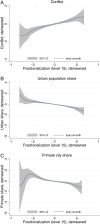Ethnolinguistic diversity and urban agglomeration
- PMID: 32601187
- PMCID: PMC7368271
- DOI: 10.1073/pnas.2002148117
Ethnolinguistic diversity and urban agglomeration
Abstract
This article shows that higher ethnolinguistic diversity is associated with a greater risk of social tensions and conflict, which, in turn, is a dispersion force lowering urbanization and the incentives to move to big cities. We construct a worldwide dataset at a fine-grained level on urban settlement patterns and ethnolinguistic population composition. For 3,540 provinces of 170 countries, we find that increased ethnolinguistic fractionalization and polarization are associated with lower urbanization and an increased role for secondary cities relative to the primate city of a province. These striking associations are quantitatively important and robust to various changes in variables and specifications. We find that democratic institutions affect the impact of ethnolinguistic diversity on urbanization patterns.
Keywords: conflict; democracy; ethnolinguistic diversity; fractionalization; urbanization.
Conflict of interest statement
The authors declare no competing interest.
Figures




References
-
- Montalvo J. G., Reynal-Querol M., Ethnic polarization, potential conflict, and civil wars. Am. Econ. Rev. 95, 796–816 (2005).
-
- Esteban J., Mayoral L., Ray D., Ethnicity and conflict: An empirical study. Am. Econ. Rev. 102, 1310–1342 (2012).
-
- Esteban J., Morelli M., Rohner D., Strategic mass killings. J. Polit. Econ. 123, 1087–1132 (2015).
-
- Mueller H. F., Rohner D., Schönholzer D., “The peace dividend of distance: Violence as interaction across space” (Discuss. Pap. 11897, Centre for Economic Policy Research, 2017).
-
- Henderson V., The urbanization process and economic growth: The so-what question. J. Econ. Growth 8, 47–71 (2003).
Publication types
LinkOut - more resources
Full Text Sources

